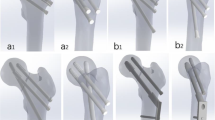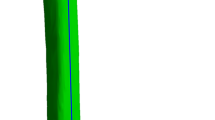Abstract
Objective
In this study, we aimed to evaluate the biomechanical behavior of three fixations for Pauwels type III fractures (sliding hip screw (SHS), L-shaped, and L-shaped with medial plate), by finite element analysis (FEM).
Methods
Three internal fixators were developed to treat Pauwels type III fracture by finite elements: SHS; L-shaped; and L-shaped with medial plate. Under the same conditions, localized and total vertical fracture displacement, maximum and minimum principal and von Mises stresses were evaluated.
Results
The localized and total vertical displacement evaluated for the SHS, L-shaped, and L-shaped with medial plate were 0.15 mm, 0.17 mm, and 0.07 mm (localized), and 4.52 mm, 6.97 mm, and 6.83 mm (total), respectively. The maximum values obtained in the upper region of the femoral neck for the internal fixations were 1.43 MPa, 1.29 MPa, and 1.24 MPa, and the minimum values obtained in the lower region of the femoral neck were − 0.73 MPa, − 1.09 MPa, and − 1.03 MPa, respectively. The maximum Von Mises peak stress values were 6.35 MPa, 10.7 MPa, and 16.2 MPa for the fixation models using the SHS, L-shaped, and L-shaped with medial plate, respectively.
Conclusion
The present FEM analysis showed that SHS yields better results in terms of total vertical displacements, maximum distribution, and Von Mises peak stresses reduction. On the other hand, the L-shaped construction plus a medial plate decreases localized vertical displacements and maximum principal distribution when compared to the SHS and L-shaped constructions. These results demonstrate that both constructions, SHS and L-shaped plus a medial plate, are biomechanically efficient for the fixation of Pauwels type III femoral neck fractures.




Similar content being viewed by others
References
Panteli M, Rodham P, Giannoudis PV (2015) Biomechanical rationale for implant choices in femoral neck fracture fixation in the non-elderly. Injury 46(3):445–452
Gullberg B, Johnell O, Kanis JA (1997) World-wide projections for hip fracture. Osteoporos Int 7(5):407–413
Samsami S, Saberi S, Sadighi S, Rouhi G (2015) Comparison of three fixation methods for femoral neck fracture in young adults: experimental and numerical investigations. J Med Biol Eng 35(5):566–579
Shen M, Wang C, Chen H, Rui YF, Zhao S (2016) An update on the Pauwels classification. Journal of orthopaedic surgery and research 11(1):1–7
Parker MJ (2009) Results of internal fixation of Pauwels type-3 vertical femoral neck fractures. J Bone Joint Surg Am 91:490–491
Bartonicek J (2001) Pauwels’ classification of femoral neck fractures: correct interpretation of the original. J Orthop Trauma 15(5):358–360
Li J, Zhao Z, Yin P, Zhang L, Tang P (2019) Comparison of three different internal fixation implants in treatment of femoral neck fracture—a finite element analysis. Journal of Orthopaedic Surgery and Research 14(1):1–8
Wang G, Tang Y, Wu X, Yang H (2020) Finite element analysis of a new plate for Pauwels type III femoral neck fractures. J Int Med Res 48(2):300060520903669
Cha YH, Yoo JI, Hwang SY et al (2019) Biomechanical evaluation of internal fixation of Pauwels type III femoral neck fractures: a systematic review of various fixation methods. Clin Orthop Surg 11(1):1–14
Tianye L, Peng Y, Jingli X et al (2019) Finite element analysis of different internal fixation methods for the treatment of Pauwels type III femoral neck fracture. Biomed Pharmacother 112:108658
Haidukewych GJ, Rothwell WS, Jacofsky DJ, Torchia ME, Berry DJ (2004) Operative treatment of femoral neck fractures in patients between the ages of fifteen and fifty years. J Bone Joint Surg Am 86(8):1711–1716
Stoffel K, Zderic I, Gras F et al (2017) Biomechanical evaluation of the femoral neck system in unstable Pauwels III femoral neck fractures: a comparison with the dynamic hip screw and cannulated screws. J Orthop Trauma 31(3):131–137
Freitas A, Torres GM, Souza AC, Maciel RA, Souto DR, Ferreira GN (2014) Analysis on the mechanical resistance of fixation of femoral neck fractures in synthetic bone, using the dynamic hip system and an anti-rotation screw. Rev Bras Ortop 49(6):586–592
Baitner AC, Maurer SG, Hickey DG, Jazrawi LM, Kummer FJ, Jamal J, Goldman S, Koval KJ (1999) Vertical shear fractures of the femoral neck. a biomechanical study. Clin Orthop Rel Res 367:300–305
Giordano V, Paes RP, Alves DD et al (2018) Stability of L-shaped and inverted triangle fixation assemblies in treating Pauwels type II femoral neck fracture: a comparative mechanical study. Eur J Orthop Surg Traumatol 28(7):1359–1367
Mir H, Collinge C (2015) Application of a medial buttress plate may prevent many treatment failures seen after fixation of vertical femoral neck fractures in young adults. Med Hypotheses 84(5):429–433
Giordano V, Alves DD, Paes RP et al (2019) The role of the medial plate for Pauwels type III femoral neck fracture: a comparative mechanical study using two fixations with cannulated screws. J Exp Orthop 6(1):1–9
Giordano V, Giordano M, Glória RC et al (2019) General principles for treatment of femoral head fractures. J Clin Orthop Trauma 10:155–160
Zlowodzki M, Ayieni O, Petrisor BA, Bhandari M (2008) Femoral neck shortening after fracture fixation with multiple cancellous screws: incidence and effect on function. J Trauma Acute Care Surg 64(1):163–169
Stockton DJ, Dua K, O’Brien PJ, Pollak AN, Hoshino CM, Slobogean GP (2019) Failure patterns of femoral neck fracture fixation in young patients. Orthopedics 42(4):e376–e380
Kh S, Sh H, Sb H (2020) Posterior fully threaded positioning screw prevents femoral neck collapse in Garden I or II femoral neck fractures. Injury 51(4):1031–1037
Author information
Authors and Affiliations
Corresponding author
Ethics declarations
Conflicts of interest
The authors declare that they have no conflict of interest.
Additional information
Publisher's Note
Springer Nature remains neutral with regard to jurisdictional claims in published maps and institutional affiliations.
Rights and permissions
About this article
Cite this article
Freitas, A., Bontempo, R.L., Azevedo, F.A.R. et al. New fixation method for Pauwels type III femoral neck fracture: a finite element analysis of sliding hip screw, L-shaped, and L-shaped with medial plate. Eur J Orthop Surg Traumatol 31, 1069–1075 (2021). https://doi.org/10.1007/s00590-020-02824-x
Received:
Accepted:
Published:
Issue Date:
DOI: https://doi.org/10.1007/s00590-020-02824-x




